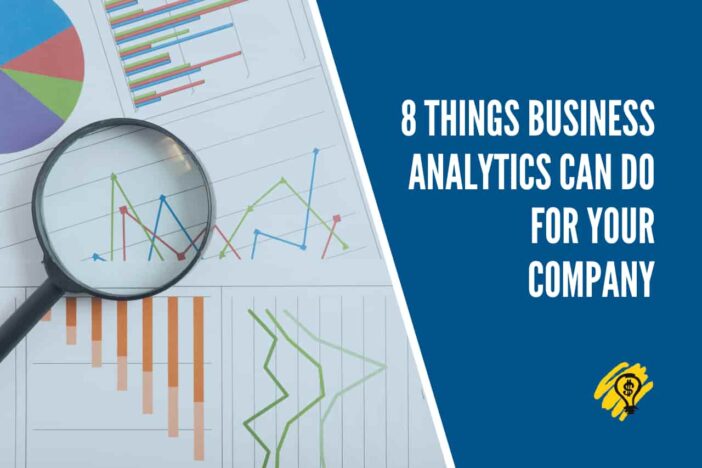Business analytics is the process of using data to make decisions. Data can be used to look at past and current situations, and it can also be used to predict future events. Data can show what has happened, what is happening, and what will happen. Data can be used to help make decisions regarding your business or organization by analyzing information such as sales figures, customer preferences, employee performance, and more.
Not only does data provide insight into your organization’s current situation, but it can also help identify areas for improvement, so you know whether or not something needs adjusting in order to reach desired outcomes. If this description has piqued your interest, there are many online platforms where you can learn more about business analytics, but for now, let’s look at what this kind of data-driven work can do for your business.
Improve Operations
Business analytics can help you improve operations by increasing your focus on understanding and improving the business. You’ll be able to understand the customer journey, use data to understand how to improve it, and make sure that you’re constantly improving your product or service. Business analytics will also help you understand how to improve customer relationships and deliver a better experience for your customers.
Drive Better Decisions
You can use data to make better decisions. In fact, it’s best for your business if you do. Business analytics help you make better decisions by providing you with objective data that informs every aspect of your business, from marketing and sales to operations and finance.
It may sound clichéd to say “data-driven decisions are better than decisions based on intuition,” but it’s true: research has shown that companies who rely on data in their decision-making have higher revenue growth rates than those who don’t.
Whether it’s driving greater revenue through lower costs or improving customer satisfaction through improved service, we’ve seen time and again that businesses that utilize analytics are able to deliver more profitable results than those that don’t.
Increase Revenue
There are many ways to increase revenue using business analytics. Using the data a business analytics program aggregates, you can get more customers to buy more frequently and get them to buy more expensive products.
You can lower the cost of making sales, then increase the price of your product. You can open up new markets, sell more products to existing customers, or increase the average size of your customer’s transactions. The possibilities are endless.
Reduce Costs
The fourth thing business analytics can do for your business is reduce costs. Reducing costs doesn’t just mean cutting the price of products or services. You can also use data to find ways to reduce expenses and improve efficiency. If you’re already doing this, great! But there are still ways that you can use BI tools to make things even more efficient.
A few examples of how analytics helps a company reduce its costs:
- Analytics helps identify which parts of a process are most expensive and which ones offer value in comparison so that you know where to spend your money wisely when making improvements or changes.
- It allows managers to see exactly where they need more staff members so that they don’t waste money hiring more people than necessary (or worse yet—not enough!)
Improve Customer Experience and Retention
As any tightly run business operation knows, customer experience and retention are the most important things to consider when running a business. They’re about creating a positive experience for your customers so that they leave satisfied and loyal. This can lead to increased sales, which is why it’s so important to measure both of these things in detail.
With the analytics software, you can get an accurate picture of how happy your customers are with what you offer them. You can also identify areas where improvements are needed so that your company can continue meeting the needs of its audience as they change over time.
Identify New Opportunities and Markets
A great way to identify new opportunities and markets is to look at gaps in the market. If you have a product or service that fills one of these gaps, it may be an opportunity for growth. For example, if you sell widgets but don’t offer a widget with a specific feature (say, color), then there might be an opportunity for you to introduce a new offering that meets this need.
Another way to find opportunities is by looking at gaps in your product line. For example, maybe there’s something similar enough in terms of what it does but not exactly what people want or need.
Maybe they can’t get it at all because no one else makes the thing or sells them. Maybe it exists but isn’t good enough quality, so people don’t buy it. But if you could make something better than any other option out there, then perhaps there would be demand for such an improved version of whatever that thing was!
Manage Risk
Business analytics helps you to manage risk by helping you understand the probability of an event and its impact on your business. This can be done through understanding historical data and identifying patterns, predicting future events, or performing scenario analysis.
The information provided by business analytics allows you to assess your risk-reward trade-offs and make better decisions about whether to pursue a particular opportunity or avoid it altogether. Business Analytics can help with assessing the potential impact of an event.
Optimize Marketing Campaigns
You can use data to optimize your marketing campaigns and maximize their impact.
- You can increase customer retention: The first thing you should do is identify your most valuable customers and then determine how to retain them.
- You can increase customer satisfaction: Once you know who you want to keep, try different strategies for retaining them, such as sending thank-you notes or offering special discounts.
- You can increase customer spending: Customers who are happy with the service they’ve received are more likely to spend more money with you in the future. This is why it’s so important that businesses don’t give up on reaching out after a sale has been made!
- You can improve customer loyalty: If people like what they’re getting from working with your company, then they’ll be more likely to come back again and again (and tell other people about it).
Learning About Business Analytics Will Help You Understand How to Use Your Data to Make More Informed Decisions
It’s not enough just to know what data you have and how it can be useful. You need to understand the process of taking data from many different sources and turning that information into something meaningful. This is where business analytics comes in.
As we’ve discussed before, business analytics is the process of using data to make better decisions -decisions that will help your business grow, thrive, and succeed. There are two chief steps involved when it comes to analyzing your data:
- Getting the right data: If you don’t have all of the necessary information, then there isn’t anything for you (or anyone else) to analyze! Your company may not have access to all of its own internal systems yet, but there are plenty of external tools available which provide easy access to key metrics like web traffic or customer satisfaction ratings so that anyone can see what’s going on with their website traffic at any given time without having full access rights themselves.
- Analyzing correctly: Once we’ve got our hands on some actual numbers from those internal systems (or external ones), we need some way of figuring out how much importance each piece has relative to others before putting them together into something useful for decision.
Once you’ve mastered every aspect of business analytics and applied it to your business model, your company’s growth should pick up speed.





